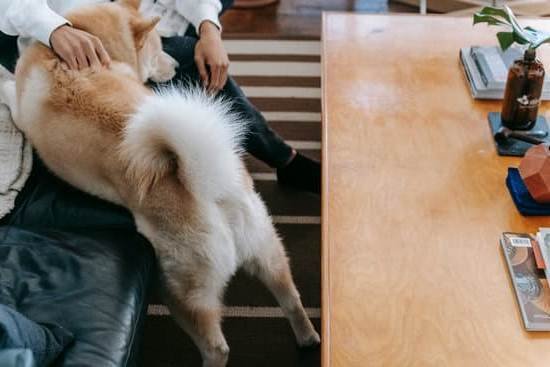Are you tired of your dog scratching or barking at the door to be let outside? How about teaching them to ring a bell instead? Training your dog to ring a bell at the door is a practical and effective way to communicate with your pet. In this article, we will explore the benefits of teaching this behavior, share success stories, and emphasize the importance of clear communication between you and your furry friend.
Many pet owners have experienced the frustration of their dogs not being able to effectively communicate their needs when it comes to going outside. By training your dog to ring a bell, you can eliminate this frustration and create a simple and reliable way for them to alert you. We will also discuss different types of bells, factors to consider when selecting one, as well as where to find the perfect bell for your pet.
Additionally, we’ll provide step-by-step guidance on introducing the bell to your dog while emphasizing patience and consistency during the training process. Developing a cue for the bell and encouraging independence in using it are also essential aspects that we will cover. Lastly, we will address common challenges that may arise during training and offer solutions for reinforcing and evolving this behavior over time. Get ready to enhance communication with your furry companion.
Selecting the Right Bell
When it comes to training your dog to ring a bell at the door, selecting the right bell is a crucial first step. There are various types of bells available, each with its own benefits and drawbacks. It’s essential to choose a bell that is durable, easily accessible for your dog, and fits seamlessly into your home environment.
Different Types of Bells
There are several options when it comes to selecting a bell for your dog. Some popular choices include jingle bells, electronic doorbells with a push button, and sleigh bells. Jingle bells are a classic choice and produce a distinct sound that can be easily heard.
Electronic doorbells are convenient as they can be placed at the dog’s level and activated with a simple push. Sleigh bells provide a traditional and festive sound that can be charming for both you and your pet.
Factors to Consider
When choosing the right bell for training, consider factors such as the size of your dog, the volume of the bell’s sound, and ease of use. For smaller dogs, lighter bells with softer tones may be preferred, while larger dogs may require sturdier bells with louder sounds. Additionally, consider how the bell will fit into your daily routine and living space.
Where to Purchase
The perfect bell for your dog can be found in pet supply stores, online retailers specializing in pet products, or even in general home goods stores. When making a purchase decision, read customer reviews or seek recommendations from fellow pet owners to ensure that you’re selecting a high-quality and effective bell for training purposes. By choosing the right bell based on your dog’s needs and lifestyle, you set the stage for successful training sessions ahead.
Preparing the Training Area
When training your dog to ring a bell at the door, it is crucial to select the right location for placing the bell. The bell should be easily accessible to your pet but positioned in a way that does not obstruct foot traffic or cause any inconvenience.
Ideally, the bell should be placed at nose height for your dog, allowing them to interact with it comfortably. Consider the layout of your entryway and choose a spot where the bell can be easily noticed and used by your dog.
Creating a Positive Environment for Training
Creating a positive atmosphere during training sessions is essential for encouraging your dog to engage with the bell. Ensure that the area where you set up the bell is associated with positive experiences for your pet. This can include offering treats, verbal praise, and physical affection when your dog shows interest in or interacts with the bell. By associating positivity with the training area, you are reinforcing the behavior you want to encourage.
Ensuring the Area Is Free From Distractions
Another important aspect of preparing the training area is minimizing distractions that may hinder your dog’s focus on ringing the bell. Remove any items or stimuli that might divert their attention away from using the bell when they need to go outside.
This can include clearing clutter around the door, closing windows or doors that lead to high-traffic areas, and limiting loud noises during training sessions. Creating an environment free from distractions will help your dog concentrate on learning this new skill effectively.
Teaching the Initial Bell Ring
Teaching your dog to ring a bell at the door can be a game-changer for both pet and owner. The ability to communicate when they need to go outside can prevent accidents in the house and strengthen the bond between you and your furry friend. When I first started training my dog to ring a bell, I was amazed at how quickly he caught on, and it became such a useful skill for both of us.
To begin teaching your dog to ring a bell, selecting the right type of bell is crucial. There are various options available, including jingle bells, hanging bells, or even electronic doorbells designed for pets. Consider factors such as the size of your dog, the sound that will be most distinguishable to them, and the durability of the bell. In my experience, I found that using jingle bells attached to a strap worked best for my dog.
Once you have chosen the perfect bell for your dog, it’s essential to prepare the training area. Place the bell near the door where your dog typically goes out for potty breaks or walks. This helps create a clear association between the bell and going outside. Set up a comfortable training environment with minimal distractions, as this will aid in focusing your pet’s attention on learning this new skill.
Develop a Cue for the Bell
Once your dog has learned to ring the bell consistently, it’s important to establish a clear cue that signals to them when it’s appropriate to ring the bell. This cue can be verbal, such as saying “outside” or “potty time,” or it can be a specific action, such as pointing to the bell or pressing a specific button.
The key is to make sure your dog understands what action is expected of them when they hear or see the cue.
When introducing the cue, it’s essential to use it consistently and in conjunction with the behavior you want from your pet. For example, if you choose the verbal cue “outside,” say this phrase just before leading your dog to the door and having them ring the bell. Eventually, your furry friend will associate the cue with ringing the bell and will respond accordingly when they hear it.
To reinforce this association, practice using the cue in different scenarios and locations. This will help solidify your dog’s understanding of what is expected when they hear or see the cue, leading to more consistent behavior in various situations. Remember that positive reinforcement, such as treats and praise, should accompany successful responses to the cue to encourage continued adherence to this behavior.
Lastly, be patient and consistent when developing a cue for the bell with your dog. Every pet learns at their own pace, so providing clear communication and plenty of positive reinforcement will go a long way in helping them understand and respond to your chosen cue.
| Developing a Cue | For Bell Ringing |
|---|---|
| Establish clear cues | Verbal or visual cues for ringing |
| Use cues consistently | Reinforce with treats and praise |
| Practice in different scenarios | Patience & consistency are key |
Encouraging Independence
Once your dog has mastered the initial bell ringing training, it is important to encourage independence in this behavior. This not only provides a sense of accomplishment for your pet but also establishes clear communication between you and your dog.
One method for promoting independence is to gradually increase the distance between your dog and the door when practicing bell ringing. Start by standing closer to the door with your dog, and as they become more confident, slowly move away while giving them the cue to ring the bell.
Another approach to promoting independence in bell ringing is to introduce subtle challenges during training. For example, you can simulate common scenarios such as being occupied with a task or having other family members present, requiring your dog to take the initiative in signaling their need to go outside. By exposing them to these situations during practice sessions, you are reinforcing the idea that bell ringing is an independent action on their part.
Consistency in training plays a crucial role in encouraging independence in bell ringing. Ensure that everyone in the household follows the same training guidelines and cues, providing a cohesive environment for your dog to thrive in this behavior. By consistently reinforcing their confidence and capability through positive reinforcement, you are setting the stage for an independent and effective communication method with your pet.
Troubleshooting Common Issues
When training your dog to ring a bell at the door, it’s important to be aware of common challenges that may arise during the process. Addressing these issues effectively will ensure that your training is successful and that your pet is able to communicate their need to go outside clearly. Here are some common problems you may encounter and how to troubleshoot them:
1. **Resistance to the Bell**: If your dog shows resistance or fear towards the bell, it’s important to address this issue with patience and positive reinforcement. Start by associating the bell with something positive, such as treats or playtime. Encourage your dog to approach the bell on their own terms and reward any interaction with praise and rewards.
2. **Lack of Progress**: Some dogs may take longer to understand and engage with the bell ringing behavior. In such cases, it’s crucial to continue being patient and consistent in your training efforts. Reinforce small instances of interaction with the bell and gradually increase expectations as your pet becomes more comfortable.
3. **Inconsistent Ringing**: Your dog may initially show excitement in ringing the bell but then lose interest or become inconsistent in their behavior. This could indicate a lack of clear communication or reinforcement on your part. Ensure that you are consistently rewarding desired behavior and practicing the cue in different scenarios to reinforce its importance.
Addressing these common issues with understanding, patience, and effective training techniques can help overcome any challenges in teaching your dog to ring a bell at the door. Remember that every dog learns at their own pace, so maintaining a positive attitude and consistent approach is key to success in this training endeavor.
Reinforcing and Evolving the Behavior
In conclusion, training your dog to ring a bell at the door can be a rewarding and beneficial experience for both you and your pet. By establishing clear communication and promoting independence, you can create a positive behavior that not only enhances your dog’s confidence but also facilitates their ability to communicate their needs effectively.
The journey of reinforcing and evolving this behavior is an ongoing process that requires patience, consistency, and a deep understanding of your dog’s individual learning style.
As you continue to reinforce the bell ringing behavior over time, it is important to celebrate small successes along the way. Positive reinforcement, such as verbal praise or treats, will not only motivate your dog but also strengthen the bond between you. Additionally, consider expanding the use of the bell to include other door-related behaviors such as signaling when they need to go outside or come back in. This will further enhance their communication skills and overall obedience.
It’s essential to adapt the training process based on your dog’s progress and any challenges that may arise. If you encounter resistance or lack of progress, don’t be discouraged. Identify the root cause of the issue and adjust your approach accordingly.
Every dog is unique, so being flexible in your training methods will ultimately lead to success in reinforcing and evolving the desired behavior of bell ringing at the door. By consistently working with your pet and celebrating each milestone achieved, you can create a harmonious relationship built on effective communication and mutual understanding.
Frequently Asked Questions
How Do You Train a Dog to Use a Bell on a Door?
Training a dog to use a bell on a door involves positive reinforcement and consistency. Start by hanging the bell low enough for your dog to nudge with its nose or paw. Then, every time you take your dog outside, encourage them to touch the bell before opening the door.
When they do, immediately praise and reward them with a treat or verbal praise. With consistent training, your dog will learn to associate ringing the bell with going outside.
How Do I Get My Dog to Ring the Bell?
To get your dog to ring the bell, start by showing them how it’s done. Use their paw or nose to gently tap the bell so they can hear the sound it makes.
Next, encourage them to touch the bell themselves, using treats and praise as rewards for doing so. Be patient and consistent with this training process, and eventually your dog should start ringing the bell on their own when they need to go outside.
Do Bells on the Door Work for Dogs?
Bells on doors can work well for dogs as a way for them to communicate when they need to go outside. Many dogs quickly learn to associate ringing the bell with being let out, making it an effective communication tool between pets and their owners.
However, success with bells on doors depends on consistent training and reinforcement of the behavior you want from your dog in relation to the bell. Overall, bells on doors can be a helpful tool for both pet owners and their dogs.

Welcome to the blog! I am a professional dog trainer and have been working with dogs for many years. In this blog, I will be discussing various topics related to dog training, including tips, tricks, and advice. I hope you find this information helpful and informative. Thanks for reading!





